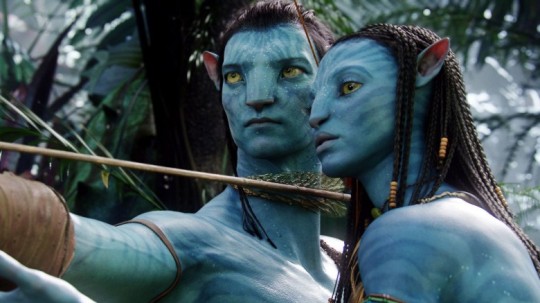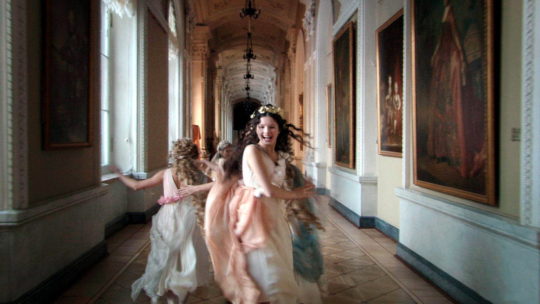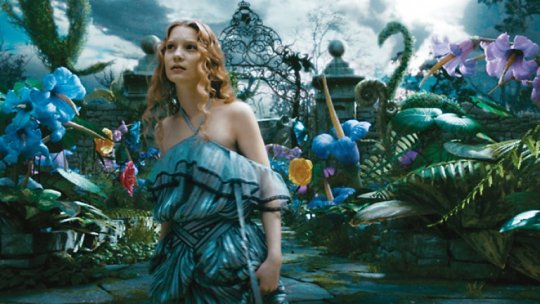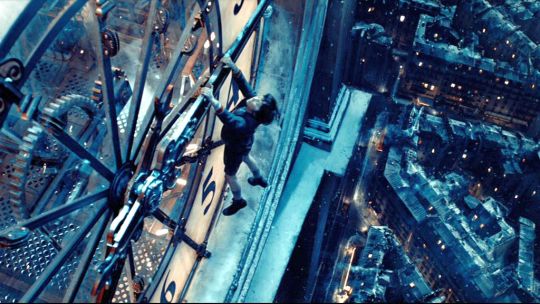3D, Part 1: James Cameron and the Broken Promise of the Third Wave
By Yasmina Tawil

[Note: This essay is the first in a two-part series on 3D. Part 2, coming soon, will discuss the unexpected peak of 3D as an artistic form. —ed.]
It’s not fair to say that James Cameron ruined projection standards by pushing for a digital changeover—the industry impetus was already under way—but Avatar left less of an impression as a movie than as technological advocacy, resulting in unintended, still-lingering side effects. Cameron dreamed of 3D cinema arriving, finally, at what he viewed as its overdue narrative fruition; he couldn’t have imagined compromising projection standards or undermining film archiving in the process. This is a two-part essay: The first is a grim recap of the Third Wave of 3D, which has unfolded over the last decade. The second will advocate for a secret classic of 3D cinema at its inadvertently experimental peak.
****

The not-too-reductive standard narrative goes like this: 3D was popularized contemporaneously with widescreen in the ‘50s as half of a two-pronged initiative to lure audiences away from their TV screens by giving the theatrical experience something unavailable at home. By decade’s end, widescreen was normalized; ’60s and ‘70s one-offs excepted, 3D wasn’t. 1980’s Comin’ at Ya! kicked off its second wave, which had a similarly short lifespan. In both runs, 3D failed to transition from passing gimmick to standard filmmaking option, mostly due to the diminishing thrill of seeing things flying at you, but also due to technological flaws that made the results physically difficult to watch. This history’s a bit of an oversimplification: like sound, color, and widescreen (all of which were experimented with long before they became standard options), 3D had test-run incarnations well before its ‘50s boom. Still, this story is largely accurate. So what makes the third wave different?
Cameron’s ideal 3D would be to create totally immersive worlds, refusing to throw objects at viewers the way the first two 3D waves had done. These effects were presumably cheap grabs for attention, while Cameron was focused more on depth rather than breaking the proscenium. In a (troublesomely unattributed) quote from 2009, a collaborator summed up his approach: “There’s a scene early in [Avatar] where something jumps out of the screen. Jim said, `I just did that so that they would know I know how to do it. But then I stopped doing it because that’s not what 3D is; 3D is bringing the audience completely into the environment of the movie.’” Narrative disruption was not on the agenda; Cameron’s films have always followed conventional dramatic arcs, and Avatar has a particularly unchallenging (“archetypal”) story. This meant yoking 3D to digital projection, which would straighten out the format’s numerous problems once and for all by eliminating both the visual eyestrain and eyeline problems of watching 3D, either polarized (the default standard until digital) or in anaglyph (the infamous red-and-blue glasses format that became a stand-in image for the format, despite being relatively rare) and the double potential for error caused by an incompetent projectionist. Cameron had spent years preparing audiences—and, more importantly, the industry—for a digital conversion. In 2005, he, George Lucas, and Peter Jackson appeared at ShoWest, the trade theater convention to boost for 3D and, by association, digital projection. “I’m giving you guys plenty of warning,” Cameron said. “You’ve got two years to get ready.” His timeline was off, the larger idea was not: In 2009, 16,000 screens worldwide were digital-ready. The next year, that had shot up to 36,000.

It’s not clear digital projection is the optimal way to see Avatar; the late 3D advocate Ray Zone saw the film five times in multiple formats in its first run, concluding not only that film-based IMAX 3D (with two 70mm projectors running simultaneously) was the correct way to see the film, but that “One hint that IMAX 3-D 15/70mm was the native 3-D format for Avatar was that the new large platters would only hold two hours and forty minutes of 15/70mm film—the exact running time of the film.” Nonetheless, Avatar’s overwhelming success sped up a slow-moving push to digital conversion, which the industry had been inching towards for some time. George Lucas had some digital screenings of Phantom Menace, but locally, I remember digital first rearing its head at the arthouse—specifically Austin’s long-closed four-screen Dobie Theatre, an independent that had by then been bought by Landmark Theatres. The arthouse chain went in early for digital projectors, a bright future ushered in Windows Media Player 9. (From a press release at the time: “The film is a milestone in digital origination — a genuine work of art that takes full advantage of new technology. Windows Media 9 Series will show it in all its glory.”) “We can hear the techies in the crowd oohing and ahhing already,” The Austin Chronicle’s Marc Savlov wrote. “It’ll only be a matter of time before the entire industry goes digital and the notion of scratched and blotchy film and frazzled frame adjustments will seem very quaint indeed. Progress, baby. We live for it.” My first screening in that format was Russian Ark, Alexander Sokruov’s one-take Hermitage film that would have been impossible to realize on celluloid, with its inherent time limits on how long each reel can be. That projection (the Dobie was only one of four US theaters to play it that way in the film’s initial run) made sense: digital in, digital out.
Still, the stakes of first digital conversion were relatively small; Avatar’s success upped digital’s presence significantly while coupling it to 3D. This is the part that’s different: where previous pushes for 3D worked with (extensively) modified versions of existing film hardware, this time the medium’s perfection accelerated the wholesale rethinking of film production and exhibition. Striking and shipping 35mm prints was expensive, as was paying qualified projectionists, and said prints would get beat up; the longer you waited to see a film, odds were the worse it would look. And “qualified” projectionists certainly weren’t the baseline standard by any means: I remember going to see Talk to Her improperly projected in 2002, the frame misaligned so that the bottom of the frame showed as a sliver at the top from start to finish. (Here’s a much more dramatic projection fail story from back in the day; probably everyone has at least one.) As with any new tech rollout, unforeseen problems followed: smaller theaters crowdsourced funds for new projectors or risked going out of business, digital files proved anything but foolproof in practice, a push for digital archiving placed the history of film at risk as new storage formats proved highly unstable relative to well-preserved film. (This last sentence is a heavily compressed version of what David Bordwell tracked at length in his highly recommended “Pandora’s Digital Box” series.) More succinctly, this is the first time 3D introduced a specific ghost in the machine: every time you go to a multiplex to see a movie that looks way too dark, the odds are good someone left the 3D lens on, and no one’s around who can fix it or who would even care to. What started as an attempt to perfect 3D had the inadvertent effect of undoing 2D digital projection standards.

Again, none of this is directly James Cameron’s fault. He’s just the one who helped push through a change faster than it might have been implemented otherwise. Avatar’s blockbuster breakthrough was followed the next year by Alice in Wonderland, which harvested a billion-plus dollars worldwide, making the case that it didn’t matter whether 3D was native or, as in Tim Burton’s film, post-converted. Not a year later, Jeffrey Katzenberg—another 3D booster—was already worried “the bloom was off the rose” because cynical types “thought they could just deliver a kind of low-end crappy version of it, and people wouldn’t care, or wouldn’t know the difference.” Five years later, Katzenberg was blunter, quoting (intentionally or not) Easy Rider to convey the extent of his disappointment: “we blew it.” 3D’s never had as big a year since 2010: its revenue has declined every year since, and production of 3D films has gone down. The technology stuck, but 3D’s potential as a normative storytelling tool remains once again questionable until further notice.
Setting aside the grim trajectory of 3D’s current wave, which has seen revenue (and audience demand) for the format decrease, it’s worth reflecting on Cameron’s original idea that 3D would add “depth” to the familiar, instead of a better brand of comin-at-ya effects. For years, whenever people would ask which 3D movies I liked, I’d say Yogi Bear. This is (not entirely) a smartass answer: obviously Goodbye to Language would be a better response, but Godard sought to dismantle all 3D’s rules one event shot at a time, and no one will (be able to) follow up on its visual inquiries. Pina made visual sense (the performers are dancing outside, depth is important), Hugo looked neat, and Tron: Legacy was a cool lightshow (though that had more to do with sheer color overload and Daft Punk’s super-loud score as rendered on the biggest speakers theatrically available, and a 3D expert friend swears it has some of the worst use of the medium he’s ever seen); otherwise, my 3D sampling has mostly been review assignments of bad-looking movies. The worst are the post-converted monstrosities. A real low here was the new Pete’s Dragon, which Disney screened in 3D: it looked extremely dark, which was predictable, but worse, a bunch of shots which were clearly shallow-focus, had all been rendered as three to four separate planes of depth, casting blurry background areas in semi-sharp relief, each shot an unintentional diorama. It was sort of possible to tell what the compositional intent was, but impossible to really envision it.

So Yogi Bear is peak 3D. Why not? At a cost of $80 million, Yogi Bear renders a depth-filled Jellystone Park entirely on par with Pandora, with all of the depth and none of the tacky colors. Both movies tell stories, both benefit from depth to spatially reconstruct a largely external environment: the differences are mostly details. In an interview Google will no longer let me find, but which I swear I remember, Cameron said only 19 shots (or thereabouts, let me hedge) in Avatar featured zero CG. These are, I presume, the shots of Jake Sully back on base; to me, they’re easily the most memorable parts of the movie, capturing the full depth of a set (and its metal walls) in a way that’s way more compelling than a fully rendered fake ecosystem . What if Cameron was wrong and 3D is, fundamentally, not just a way to enhance immersiveness but one which, when deployed in the non-CG constructed world, can recode the nuts and bolts of narrative filmmaking visual language itself? In Part II, I’ll look back at the much-derided second wave of ‘80s 3D to make the case that 1983’s Treasure of the Four Crowns, a little-regarded Raiders of the Lost Ark knock-off, is one of the format’s greatest, most progressive and inadvertently suggestive moments.


